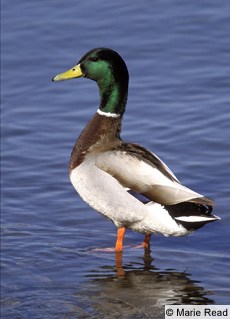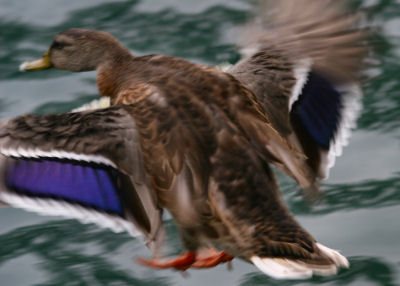The first is a guy who will be showing up a lot around here, so much so that it's really pretty fitting that he be included in the inaugural post. Anyone who has watched the Sopranos pilot (if you haven't, that's a bandwagon you just need to get on, no questions asked) knows full well how moved Tony was by the ducks in his pool - literally, their departure provoked the panic attack that sent him to therapy in the first place. His second session with Melfi establishes the ducks as an enduring trope as they discuss a dream he had the night before, in which the ducks made a furtive appearance:
So I'm at the Bronx Zoo this August with my brother (aka Jersey Boy #2), and we're just getting our bearings and figuring out our route as he points out a big old duck pond. I dismiss his suggestion that we check them out, because why hang around watching ducks you can see anywhere when you're at the BRONX ZOO?! He protests, though (I think "but I love water fowl!" were his exact words - at that, I obliged, because a line like that deserves rewarding).
Anyway, we ended up spending a good half hour there, watching the ducks, and I've gotta give the kid credit - he was right, they were kind of great. They did look pretty much like the ducks I've seen around here my whole life, but these ones seemed so much more fascinating all of a sudden! I had never noticed that, for instance, they have these lovely iridescent purple racing stripes under their wings! And they're like, GORG. I couldn't find the nameplate with the species information but I refused to believe that any New Jersey duck I'd ever seen ever had swanky purple stripes like those.
A few weeks later, I introduced my best friend to the Sopranos pilot (doing my duty to spread the gospel), and I noticed that the ducks in the Sopranos' pool boasted those same racing stripes as the ones from the zoo. Those goddamned ducks... It was time to investigate.
Sopranos ducks species wasn't especially helpful--
(although this is a great NPR blog post about the Alice's hummingbirds that had taken up residence in the author's window,
--nor was bronx zoo ducks...it was time to go macro:and here is a cute little article about a mom duck and her brood waddling around the Fox News Corp building in L.A.)
WIKI DUCKS.
Vocab lesson: The word duck comes from the Old English word for "to dive or bend down", dūcan, because of dabbling ducks' tendency to feed by sticking their heads underwater. In German and Dutch, the words for duck are Ente and eente, which probably derived from the Older Old English word for duck, æned - a cousin of the Latin anas, Lithuanian ántis, and Sanskrit ātí- all descendants of the Proto-Indo-European language. Also, I'm going to start calling female ducks hens and males drakes, okay? Because I can. And because you should.Normally I'd never steer you away from anything as amazing-looking as the mandarin drake:
...but we've gotta try to keep our focus here, people. As it turns out, Tony's ducks, the Bronx Zoo ducks, and pretty much most of the ducks I've at least ever seen in my life belong to the species known humbly as The Mallard. Apparently I've been living under a rock because I was always under the impression that mallard exclusively referred to the male everyday ducks with green heads. Who knows where I got that idea; it's true, mallard drakes have that nice green head with the yellow beak and brown feathers (ALSO: 56–65 CM LONG, 81–98 CM WINGSPAN, & WEIGHS 0.9–1.2 KG) but the light brown hens are mallards too, it turns out.
So, that's good to know, I guess. I also learned:
- all domestic ducks (with the exception of 1 species - the Muscovy duck, which we just can't get into right now) are descended from mallards
- mallards breed on every continent except Antarctica and South America (although they also spend time in Central America and the Caribbean)
- mallards lay clutches of 8-13 eggs that hatch after about 4 weeks
- mallard ducklings are precocial (they can swim and feed themselves upon hatching) and fly the nest at 50-60 days old (precocious ducklings=one of nature's cuter offerings. press play.)
- not to ruin your precocious duckling mood or anything, but you should know that mallard drakes are notorious rapists: the ones that end up without a hen-friend will band up to harass isolated single ladies, pecking and chasing them until they are too weak to fend off the males when they're taking turns having their way with her -- a phenomenon referred to as flight rape*
*MAJOR ASTERISK: mallard drakes are also known to turn their rapey tendencies on one another. it was news to the world, though when in 2003 dutch ornithologist kees moeliker, published the first recorded observation of homosexual necrophilia in mallards. In 1995 moeliker was sitting in his office in rotterdam when he heard a bird crash into the window - within a minute he found himself in front of a male mallard, copulating with the corpse of the hapless drake that had broken its neck on the glass. for his discovery, moeliker was granted the Ig Nobel Prize in biology (the ig nobel prizes are run by improbable research - an organization committed to the celebration of "research that makes people laugh and then think"). at a later date, be prepared to little more about improbable research (because it's interesting), a good amount more about kees moeliker (because he's dutch, looks kinda like my roommate, and this picture is juuuust...) and a lot more about homosexuality in non-human anymules, (because it's one of my favorite things).*
OMG ok, that was really going to be all, but I have to let you guys know that as I was reading this over before going to post it, looking at the word mallard so many times made it start to sound really weird... and I realized that while I know (and you do too, now) where the word duck came from, I didn't do my due diligence on the etymology of mallard! Well, how bout this for absurd:










No comments:
Post a Comment